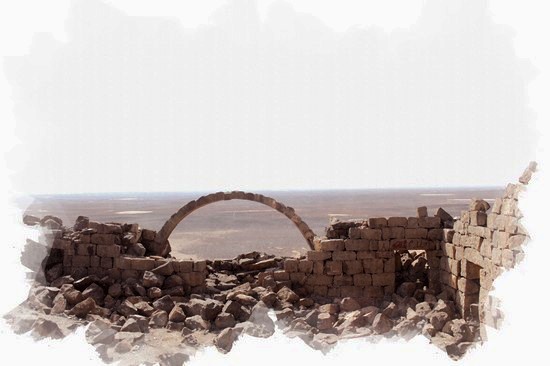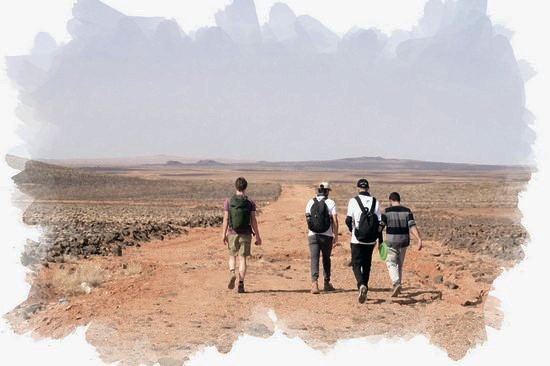The
Azraq Wetlands Reserve is one of Jordan’s lesser-known
national parks, but it is definitely worth a visit. We went independently by
car, but the reserve is managed by the
Royal Society for the Conservation of Nature (RSCN), so there are a variety of organized tours available through Wild
Jordan, an eco-tourism company which operates under the auspices of the RSCN.
اضافة اعلان
After paying for the longer tour at the reserve, which I
think is worth the additional fee if you actually want to see many birds, we
drove north up Route 40 about 20 minutes and walked about one kilometer from
our parking spot to Qasr Al-Usaykhim, a ruined fortress with sweeping views of
the barren basalt desert on the border of
Zarqa and Mafraq governorates.
 (Photo: Zane Wolfang/Jordan News)
(Photo: Zane Wolfang/Jordan News)
This week’s destination is more hidden gem than hike, and it
definitely helps to have a car. Azraq is about a two-hour drive from
Amman, and
it might be possible to get there by taking a bus to Zarqa and then another one
to Azraq, but it would be an involved logistical challenge.
The wetland reserve is as much an educational experience in
devastating ecological tragedy as it is a natural destination, and as beautiful
as the marsh is in the small area where it has been artificially preserved by
RSCN efforts to pump water back into the area, it is sad to realize what an incredibly
large, lush, and biodiverse area it used to be before the springs completely
dried out due to unsustainable human activity.
Jordan’s
Azraq Basin features large underground water
aquifers, and the area became a wetland around 250,000 BC. Since ancient times,
it served as a stop-over for migratory birds from Africa, Europe, and Asia, as
well as a waypoint for migrating humans and land mammals. An extension of
Africa’s ecosystems, Azraq and its vast wetlands used to be home to species
including the
Syrian wild ass, wild camel, rhinoceros, hippopotamus, Asian
elephant, gazelle, aurochs, Asiatic cheetah, Syrian
ostrich, Asiatic
lion, and
Arabian oryx. All these animals except for the gazelle are now extinct in
Jordan.
As recently in the 1960s, naturalists would record close to
350,000 birds stopping at the wetlands along their migration routes. In the
wake of decades of unsustainable amounts of water being pumped out of the
aquifers for urban and agricultural purposes, particularly to serve the booming
populations of Amman and Zarqa, the natural
springs completely dried up in
1992. In the mid-90s, the RSCN started pumping enough water back into the area
to restore a mere 10 percent of the wetlands, and some of the birds returned —
1,200 were recorded in the year 2000.
 (Photo: Zane Wolfang/Jordan News)
(Photo: Zane Wolfang/Jordan News)
The employees of the RSCN and the
Azraq Reserve are
passionate about conservation and the preservation of Jordan’s natural species
and habitats, and our tour of the 3km “Water Buffalo Trail” with local guide
Majd Qadi was well worth the price — JD6 for Jordanians, JD9 for residents and
students, and JD12 for foreigners.
Qadi, who is the reserve’s head eco-education officer, has
personally observed over 180 species of birds there. He pointed out different
birdsongs, cluing us in to the presence of graceful prinias and white-cheeked
bulbuls, and identified a nest in the reeds as the home of a reed warbler.
He told us how the reserve had reintroduced water buffaloes,
which were originally brought by the region’s first
Chechen migrants but
eventually died out due to the water issues. The reserve now maintains of herd
of 17, which we did not see, because they eat down some of the vegetation and
create natural trails through the marsh.
Qadi also told us, after we noticed some movement in the
water, that in addition to frogs, snakes, lizards, and crabs, the Azraq
wetlands are home to the aphanus sirhani, or Azraq toothcarp, a species of
killifish endemic to Jordan and not found anywhere else in the world. There is
a photo there from 1966 of a local man fishing with a casting-net, standing
waist-deep in the water in an area that is now completely dry and barren.
It was breathtaking, and it was also mind-boggling to see some of the bird species I know from my home on the shore of a salty estuary on the US east coast in a very similar wetland habitat in the middle of the Jordanian desert.
The highlight of the experience was our quiet entrance into
the second bird hide on the walk, a rustic hut built over one of the ponds with
short but panoramic open windows to view the marsh. Eagerly scanning with our
cameras and the binoculars provided to us at the reserve, we saw hundreds of
birds, including great white egrets, gray herons, black-winged stilts,
waterhens, terns, and a variety of ducks, including white shovelers, pintails,
little grebes, coots, and teals. We even saw a bird of prey, a marsh harrier,
calmly circling from above before settling into the reeds.
It was breathtaking, and it was also mind-boggling to see
some of the bird species I know from my home on the shore of a salty estuary on
the
US east coast in a very similar wetland habitat in the middle of the
Jordanian desert.
We were lucky to see so many species, as we learned upon our
arrival at about 11am that we were a bit early in the season and a bit late in
the day: Azraq’s peak bird-watching seasons are in the spring and autumn,
peaking in late April and mid-October, respectively, and birds are more active
early in the morning, so it is recommended to arrive at the reserve as close to
its 9am opening as possible.
 (Photo: Zane Wolfang/Jordan News)
(Photo: Zane Wolfang/Jordan News)
After leaving the reserve, we traveled north into the desert
to find Qasr Al-Usaykhim. It sits atop the tallest hill in the area, with a
commanding view of the tawny desert and fields of black basalt stones stretching
into the distance in every direction, and is built from basalt, with much of
the walls, two arches and a lower stone wall encircling the elevated site still
intact. There is no information or amenities at the site, but the
Wild Jordan
brochure explains that the fortress marked the easternmost point of the ancient
Roman empire.
The site is easy to get to and free to enter, and the
landscape is stunning, stony and barren, in stark contrast to the wetlands only
23 kilometers to the south. Seeing that landscape made the wetlands seem even
more special, and the story of their destruction at the hands of humanity all
the more devastating.
There are two other “desert castles” in the area, as well as
the Shaumari wildlife reserve and Azraq castle in the main town of Azraq, so
there are some choices to mix and match destinations and come up with your own
unique adventure.
Wild Jordan also offers a guided bicycle tour loop of the
area. Bring your own water, definitely bring your camera to the wetland reserve
if you have one, and be sure to visit the small educational exhibit inside the
reserve visitor center to learn about the ecological history of the area and
the conservation efforts of the RSCN.
Read more Where to Go



